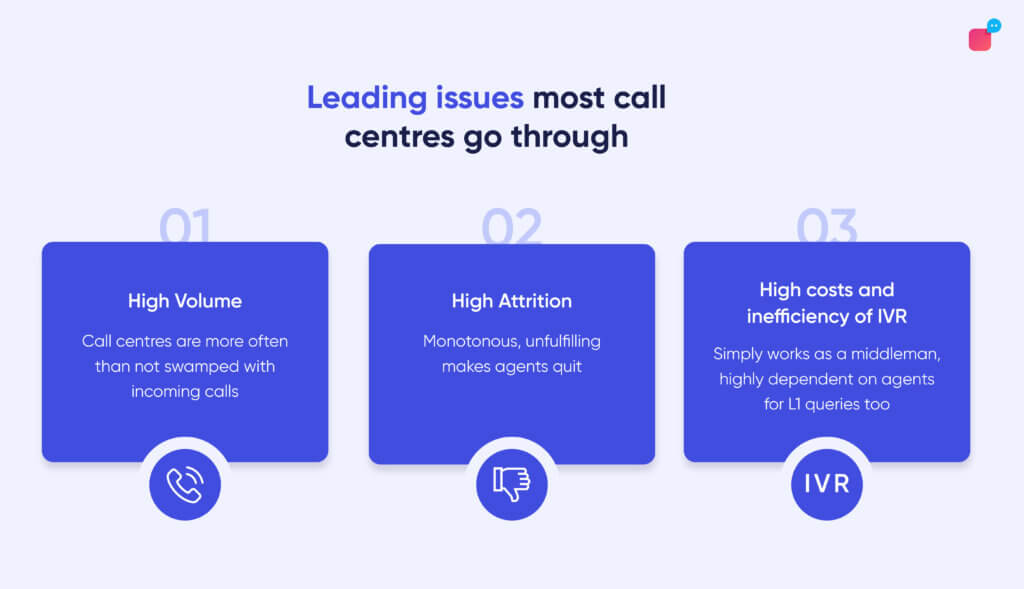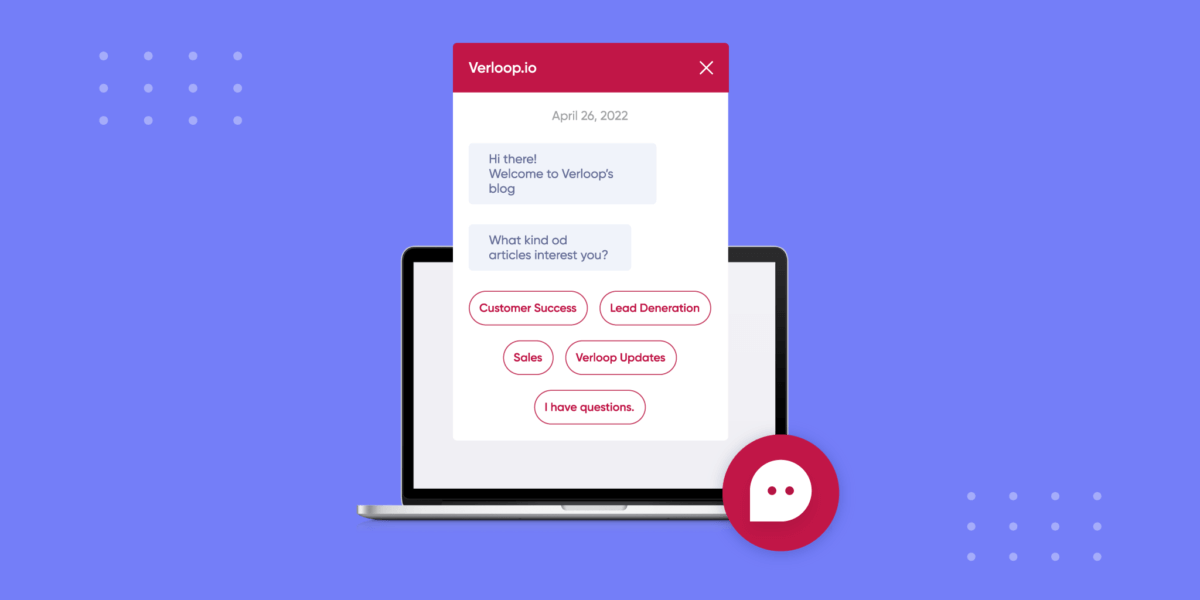6 Burning Contact Centre Challenges that Voice AI Solves With Ease
- July 22nd, 2025 / 5 Mins read
-
Aarti Nair

6 Burning Contact Centre Challenges that Voice AI Solves With Ease
- July 22nd, 2025 / 5 Mins read
-
Aarti Nair
If contact centres had a stress meter, most would be peaking in the red.
Between rising customer expectations and tightening budgets, today’s contact centres are caught in the crosshairs. The global economic slowdown has only made things harder — with many companies announcing mass layoffs, freezing new hires, and doubling down on cost-efficiency. And when the pressure mounts, it’s often the support team that feels the squeeze first.
Add to that an employee turnover rate of 30% to 45%, and you’ve got a recipe for overwhelmed agents, longer wait times, and frustrated customers. It’s a tough time to manage a contact centre — let alone scale one.
But there’s a silver lining.
Voice AI isn’t just another tech trend — it’s a practical solution built for this exact moment. By automating repetitive queries, streamlining call flows, and reducing the load on human agents, Voice AI helps support teams do more with less — without sacrificing experience or empathy.
In this blog, we’ll dive into the five most burning challenges facing contact centres today and show how Voice AI can tackle each one with precision, scale, and surprisingly low effort.
Contact Centre Challenges We Know You’re Probably Dealing With

Every successful business is heavily reliant on good customer support. But, with that success comes a number of challenges and concerns — challenges which are growing in their complexity as technology continues to evolve at a rapid pace.
Challenge 1: Managing High-Volume Calls
Call centre is the destination for ALL your customers, whether here or seven seas across, to phone in to get their queries resolved. And when operating solely, it is also the department with the busiest days and nights. High call centre volume is a persistent problem in call centres. Several factors increase call volumes, such as changes to business hours or holiday seasons. When call volume increases all at once, it’s difficult for agents to keep up with demand, which means more people have to stay on hold with annoying music. Frustrated customers will eventually skip your service. At least 42% do without a doubt.
Challenge 2: High Attrition Rates in Contact Centres
Contact centre jobs have a notoriously high turnover rate. High attrition is a clear indicator of toxic work culture. Imagine just how unfulfilling can monotonous high volume work can be?
People want to engage in meaningful work. Over 40% of agents switch employers because they feel their skills are undervalued. Call centre jobs seldom leave room for innovation and rewarding brainwork. This is when it starts reflecting on the customer experience your agents are delivering. That, or they simply quit.
Challenge 3: Low First Call Resolution (FCR)
How many times have you contacted a support line, explained your issue, only to be transferred, put on hold, or told to call back?
You’re not alone. Only 5% of contact centres achieve a world-class FCR rate of 80%+. The majority hover between 70–79%, and anything below 70% is a red flag. For customers, this means repeating themselves. For businesses, it means more agent time per ticket, higher operating costs, and lower satisfaction scores.
Voice AI solves this by instantly routing calls to the right intent, pulling up contextual history, and answering repetitive queries autonomously — often on the first try. It’s not just call deflection; it’s call resolution.
Challenge 4: Soaring Call Abandonment Rates
Let’s be honest — no one likes being put on hold.
And your customers are proving it. The industry average call abandonment rate is 6%, but the best centres keep it below 3%. That means every delay, every extra minute in the queue, is costing you business.
Voice AI shortens response times by taking over FAQs and low-complexity conversations. It acts as a frontline responder that can manage spikes in volume — even during peak hours — reducing wait times and keeping customers engaged.
Challenge 5: Dipping CSAT and Escalating Expectations
Customers today expect fast, personalised, and frictionless support. And they don’t give many chances. In fact, 1 in 3 will leave a brand after a single bad experience, and 92% after two or three.
But only 5% of contact centres hit a CSAT score above 85% — the gold standard. Most fall below that, despite their best efforts.
With Voice AI agents, you can maintain consistent quality, tone, and speed — every single time. They never get tired, frustrated, or overwhelmed. That consistency builds trust, and trust boosts satisfaction.
Challenge 6: Lagging Behind in AI Adoption
Still on the fence about AI?
By 2026, 1 in 10 customer interactions will be fully automated — a significant jump from just 1.6% in 2022. And with Conversational AI projected to reduce service costs by $80 billion, those who delay adoption risk falling behind, fast.
The opportunity is two-fold: automate the mundane to cut costs, and elevate the meaningful to retain loyalty. Voice AI enables both — at scale.
How Voice AI Can Help Contact Centres Tackle These Challenges Head-On
The challenges contact centres face aren’t new — long wait times, agent burnout, rising customer expectations — but how we solve them has radically changed. Enter Voice AI: your always-on, never-tired support ally that does more than just answer calls.
So, how does it actually help?
Speeds Up First Contact Resolution (FCR)
Instead of bouncing between departments or repeating the same issue, Voice AI understands caller intent from the get-go. It uses Natural Language Understanding (NLU) to route the conversation accurately or even resolve it completely — without human handoffs. Imagine a virtual agent that can answer policy questions, schedule appointments, or check order status — all in the first call.
The result?
Lower call transfers. Happier customers. And fewer tickets clogging up the queue.
Reduces Call Abandonment Rates
Voice AI is designed for responsiveness. When traditional IVRs or long hold queues frustrate customers into hanging up, AI agents step in instantly — no hold music required. They engage users with natural conversation, gather context, and resolve queries or escalate only when needed.
That’s how you keep abandonment rates below industry average and loyalty above it.
Lightens the Load on Human Agents
Let’s face it — most support teams aren’t short on queries. They’re short on time.
Voice AI takes over the repetitive, high-volume interactions like password resets, payment confirmations, or appointment reminders. It also summarises conversations, sends post-call notes to your CRM, and equips human agents with a head start on complex cases.
This reduces average handle time (AHT), minimises burnout, and gives your team breathing room to focus on what really matters: empathy-led conversations.
Improves CSAT With 24/7, Consistent Support
Customers don’t clock out at 6 PM — and neither does Voice AI. Whether it’s 3 AM or during a weekend rush, AI agents provide consistent service across time zones and languages.
But more importantly, they do it without sacrificing tone, speed, or accuracy. That consistency builds confidence — and confidence builds satisfaction.
Drives Smarter Operations (and Cost Savings)
With advanced analytics, Voice AI doesn’t just solve problems — it learns from them. You gain visibility into the most common issues, peak call times, and resolution trends, helping you optimise both staffing and workflows.
Plus, by automating up to 30–40% of inbound queries, Voice AI directly cuts down on cost-per-call — without cutting down on quality.
The bottom line?
Voice AI isn’t here to replace your agents. It’s here to make them better.
And in a market where loyalty is fragile, patience is thin, and efficiency is non-negotiable, that edge could make all the difference.
Voice AI is Increasing ROI and Profitability of Contact Centres
Evolution is perpetual. Newer technologies like voice AI are keeping demands and incoming call-flows in check for contact centres. Smart automation like this pays fairly well in the long term. Companies that deploy digital automation are 6% more productive than their competitors. AI-first companies also bring home 20% more ROI and profits, versus 5% of businesses that don’t use automation.
Why do you think that happens? Because automation is not only consumer-centric but also plays in favour of contact centre employees. More satisfied agents render better experiences for complex cases, which in turn makes users come back for more. Great CX is directly proportional to the revenue you generate.
The Bottom Line
While other businesses can afford to ponder over a bit longer, time is ticking for call centres. The only way to stay afloat in a saturated market is to realise customer and employee satisfaction must be mutually inclusive. Voice automation is imperative.
Gone are the days when the human touch, or rather the human voice, was limited to just the B2C interactions. Soon, businesses all over the globe will realise that their customers want more from them. They want to be heard, they want a pleasant interaction, and they want to feel valued. Verloop.io addresses all these challenges with its cutting-edge technology, with an AI-based voice recognition built on highly trained ASR and STT.
FAQs
1. Is Voice AI the same as traditional IVR systems?
Not at all. While IVRs follow fixed scripts and menu-based options, Voice AI uses natural language understanding (NLU) to have human-like conversations. It can understand intent, context, and even handle back-and-forth queries, just like a real agent.
2. Will Voice AI replace human agents in contact centres?
No — Voice AI is designed to complement human agents, not replace them. It handles repetitive, high-volume queries and empowers agents by reducing workload and providing context, so they can focus on complex, empathy-led conversations.
3. How quickly can a business implement Voice AI in its contact centre?
Implementation timelines vary based on your systems and needs, but with plug-and-play integrations and pre-trained AI models, many businesses see Voice AI go live in just a few weeks. Start small with high-volume use cases like order tracking or appointment scheduling.
4. What metrics improve after implementing Voice AI?
Companies typically see improvements in First Call Resolution (FCR), lower Average Handle Time (AHT), higher CSAT scores, and reduced call abandonment rates. Voice AI also helps reduce support costs by automating 30–40% of interactions.
5. Is Voice AI secure for handling sensitive information?
Yes. Enterprise-grade Voice AI platforms come with end-to-end encryption, GDPR/CCPA compliance, and role-based access controls. Always ensure your Voice AI solution follows healthcare, finance, or regional data security standards if required.








